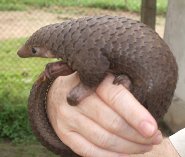 The tree pangolin (Manis tricuspis) is a small mammal that lives in the rainforest of west to central Africa. It weighs approximately 4-5 lbs (about 2 kg) and is an anteater. The body of the tree pangolin is almost completely covered in hard scales which serve to protect it from predators. The scales each have three sharp points and are layered over the entire body except for the underbelly and parts of the head. The tree pangolin has a long thick tail that is also covered in scales and helps provide support as the tree pangolin climbs the trees of the rain forest.
The tree pangolin (Manis tricuspis) is a small mammal that lives in the rainforest of west to central Africa. It weighs approximately 4-5 lbs (about 2 kg) and is an anteater. The body of the tree pangolin is almost completely covered in hard scales which serve to protect it from predators. The scales each have three sharp points and are layered over the entire body except for the underbelly and parts of the head. The tree pangolin has a long thick tail that is also covered in scales and helps provide support as the tree pangolin climbs the trees of the rain forest.The main predators of the tree pangolin are leopards, hyenas, and pythons. When approached by a predator, the tree pangolin rolls into a ball. The hard scales serve as a coat of armor and are sharp enough to injure a predator. The tree pangolin can also secrete a smelly substance from their anal glands which will also scare off a predator.
The female and male tree pangolins live alone unless the female is raising her young. The males will roam during mating season and each female will give birth to one offspring. The gestation period is 150 days and the newborn will stay with the mother for about 4 months.
The tree pangolins survive on a diet of ants, termites, and other insects. They use their claws to dig in the ground to search for food and then they capture insects with their long tongues that are coated in thick saliva. They have no teeth so they digest food by swallowing small rocks and sand that grind the food once it reaches the stomach.
The status of the tree pangolin is "near threatened" and they have been hunted by man for their meat and scales. Some cultures believe that the scales have healing powers and will protect them against evil.
Picture of the tree pangolin by Valerius Tygart, licensed under Creative Commons Attribution-Share Alike 3.0 Unported
Keywords: white
The Three-cusped pangolin, tree pangolin, white-bellied pangolin is listed as Least Concern (LR/lc), lowest risk. Does not qualify for a more at risk category. Widespread and abundant taxa are included in this category, on the IUCN Red List of Threatened Species
Countries
Angola, Benin, Cameroon, Congo, Democratic Republic of the, Congo, Republic of the, Cote d'Ivoire, Equatorial Guinea, Gabon, Ghana, Guinea, Kenya, Liberia, Nigeria, Sierra Leone, Sudan, Tanzania, Togo, Uganda and Zambia
Custom Search